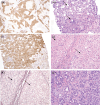The evolving role of liver biopsy: Current applications and future prospects
- PMID: 39774070
- PMCID: PMC11717517
- DOI: 10.1097/HC9.0000000000000628
The evolving role of liver biopsy: Current applications and future prospects
Abstract
Histopathologic evaluation of liver biopsy has played a longstanding role in the diagnosis and management of liver disease. However, the utility of liver biopsy has been questioned by some, given the improved imaging modalities, increased availability of noninvasive serologic tests, and development of artificial intelligence over the past several years. In this review, we discuss the current and future role of liver biopsy in both non-neoplastic and neoplastic liver diseases in the era of improved noninvasive laboratory, radiologic, and digital technologies.
Copyright © 2025 The Author(s). Published by Wolters Kluwer Health, Inc. on behalf of the American Association for the Study of Liver Diseases.
Conflict of interest statement
Marie Robert consults for Takeda, Alimentiv, Path AI, and Teva. She received grants from Astra-Zeneca. The remaining authors have no conflicts to report.
Figures


References
-
- Rockey DC, Caldwell SH, Goodman ZD, Nelson RC, Smith AD. Liver biopsy. Hepatology. 2019;49:1017–1044. - PubMed
-
- European Association for Study of Liver; Asociacion Latinoamericana para el Estudio del Higado . EASL-ALEH Clinical Practice Guidelines: Non-invasive tests for evaluation of liver disease severity and prognosis. J Hepatol. 2015;63:237–264. - PubMed
-
- Kwo PY, Cohen SM, Lim JK. ACG Clinical Guidelines: Evaluation of abnormal liver chemistries. Am J Gastroenterol. 2017;112:18–35. - PubMed
-
- Skelly MM, James PD, Ryder SD. Findings on liver biopsy to investigate abnormal liver function tests in the absence of diagnostic serology. J Hepatol. 2001;35:195–199. - PubMed
Publication types
MeSH terms
LinkOut - more resources
Full Text Sources
Medical
Miscellaneous

